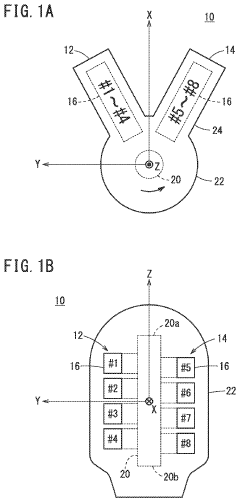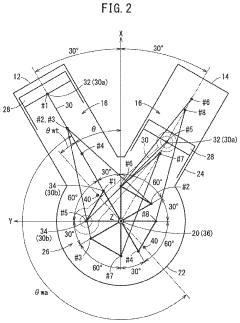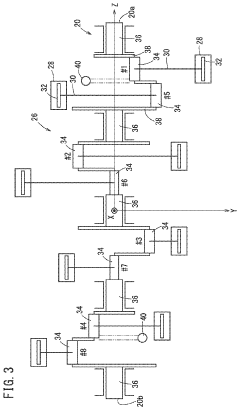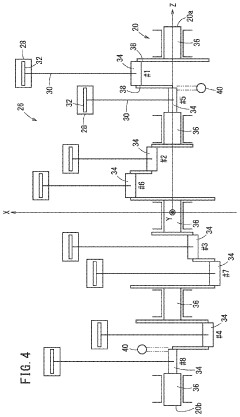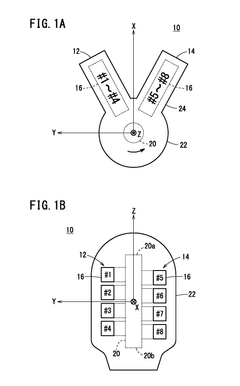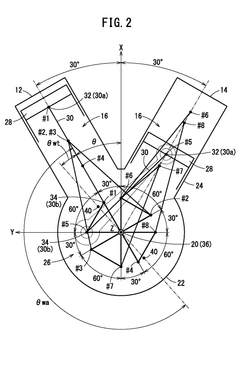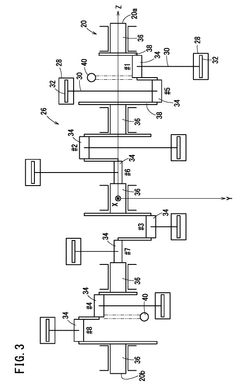How V8 Engines Develop Precision in Automotive Manufacturing?
JUL 4, 20259 MIN READ
Generate Your Research Report Instantly with AI Agent
Patsnap Eureka helps you evaluate technical feasibility & market potential.
V8 Engine Evolution
The V8 engine has undergone significant evolution since its inception in the early 20th century. Initially developed for high-performance applications, V8 engines have become synonymous with power and precision in automotive manufacturing. The evolution of V8 engines can be traced through several key phases, each marked by technological advancements and engineering innovations.
In the early stages, V8 engines were primarily used in luxury and performance vehicles. The focus was on increasing power output and improving reliability. As manufacturing techniques advanced, engineers were able to refine the design, leading to more compact and efficient V8 engines. This period saw the introduction of overhead valve designs and the implementation of more robust materials, allowing for higher compression ratios and improved performance.
The mid-20th century brought about a revolution in V8 engine development. The introduction of electronic fuel injection systems and computer-controlled engine management marked a significant leap forward in precision and efficiency. These advancements allowed for more accurate fuel metering and ignition timing, resulting in improved power delivery and reduced emissions. Concurrently, the use of lightweight materials such as aluminum for engine blocks and heads became more prevalent, contributing to overall weight reduction and enhanced performance.
As environmental concerns gained prominence, V8 engine evolution took a new direction. Engineers focused on developing more fuel-efficient designs without compromising power. This led to the introduction of variable valve timing, cylinder deactivation technologies, and direct fuel injection systems. These innovations allowed V8 engines to maintain their performance characteristics while significantly improving fuel economy and reducing emissions.
In recent years, the evolution of V8 engines has been driven by the pursuit of precision manufacturing. Advanced computer-aided design and simulation tools have enabled engineers to optimize engine geometries and combustion processes with unprecedented accuracy. The integration of sophisticated sensors and real-time monitoring systems has further enhanced engine performance and reliability. Additionally, the use of advanced manufacturing techniques, such as 3D printing for prototyping and precision machining, has allowed for tighter tolerances and more consistent production quality.
The latest phase in V8 engine evolution focuses on hybridization and electrification. Many manufacturers are now incorporating electric motors alongside V8 engines to create high-performance hybrid powertrains. This approach combines the traditional power and sound of a V8 with the instant torque and efficiency of electric propulsion, representing a bridge between conventional internal combustion engines and fully electric vehicles.
In the early stages, V8 engines were primarily used in luxury and performance vehicles. The focus was on increasing power output and improving reliability. As manufacturing techniques advanced, engineers were able to refine the design, leading to more compact and efficient V8 engines. This period saw the introduction of overhead valve designs and the implementation of more robust materials, allowing for higher compression ratios and improved performance.
The mid-20th century brought about a revolution in V8 engine development. The introduction of electronic fuel injection systems and computer-controlled engine management marked a significant leap forward in precision and efficiency. These advancements allowed for more accurate fuel metering and ignition timing, resulting in improved power delivery and reduced emissions. Concurrently, the use of lightweight materials such as aluminum for engine blocks and heads became more prevalent, contributing to overall weight reduction and enhanced performance.
As environmental concerns gained prominence, V8 engine evolution took a new direction. Engineers focused on developing more fuel-efficient designs without compromising power. This led to the introduction of variable valve timing, cylinder deactivation technologies, and direct fuel injection systems. These innovations allowed V8 engines to maintain their performance characteristics while significantly improving fuel economy and reducing emissions.
In recent years, the evolution of V8 engines has been driven by the pursuit of precision manufacturing. Advanced computer-aided design and simulation tools have enabled engineers to optimize engine geometries and combustion processes with unprecedented accuracy. The integration of sophisticated sensors and real-time monitoring systems has further enhanced engine performance and reliability. Additionally, the use of advanced manufacturing techniques, such as 3D printing for prototyping and precision machining, has allowed for tighter tolerances and more consistent production quality.
The latest phase in V8 engine evolution focuses on hybridization and electrification. Many manufacturers are now incorporating electric motors alongside V8 engines to create high-performance hybrid powertrains. This approach combines the traditional power and sound of a V8 with the instant torque and efficiency of electric propulsion, representing a bridge between conventional internal combustion engines and fully electric vehicles.
Market Demand Analysis
The market demand for precision in V8 engine manufacturing within the automotive industry has been steadily increasing over the past decade. This trend is driven by several factors, including stricter emissions regulations, the pursuit of improved fuel efficiency, and the growing consumer demand for high-performance vehicles.
Automotive manufacturers are under constant pressure to meet increasingly stringent environmental standards. Precision in V8 engine manufacturing plays a crucial role in achieving these goals by optimizing combustion processes, reducing friction, and minimizing energy losses. As a result, there is a significant market demand for advanced manufacturing techniques and technologies that can deliver the required level of precision in V8 engine production.
The global market for V8 engines, particularly in luxury and high-performance vehicles, continues to show resilience despite the overall shift towards smaller, more fuel-efficient engines. This segment of the market values the power, smoothness, and prestige associated with V8 engines, creating a sustained demand for precision manufacturing to maintain and improve these characteristics.
In the high-performance and racing sectors, the demand for precision-engineered V8 engines is particularly strong. These industries require engines that can deliver maximum power output while maintaining reliability under extreme conditions. This has led to increased investment in advanced manufacturing technologies and processes to achieve the necessary precision in engine components.
The luxury vehicle market, which often features V8 engines as flagship offerings, has shown consistent growth, especially in emerging economies. This growth has further fueled the demand for precision manufacturing techniques to produce V8 engines that meet the exacting standards of luxury vehicle buyers.
Additionally, the aftermarket and customization sectors have contributed to the demand for precision in V8 engine manufacturing. Enthusiasts and specialized tuning companies seek high-precision components to upgrade and modify existing engines, creating a niche market for precision-engineered parts.
The integration of advanced technologies such as additive manufacturing, AI-driven quality control, and IoT-enabled production lines has become increasingly important in meeting the precision requirements of V8 engine manufacturing. This has led to a growing market for specialized manufacturing equipment and software solutions tailored to the automotive industry's needs.
As the automotive industry continues to evolve, the demand for precision in V8 engine manufacturing is expected to remain strong, driven by the need for improved performance, efficiency, and compliance with regulatory standards. This presents ongoing opportunities for innovation in manufacturing processes and technologies within the automotive sector.
Automotive manufacturers are under constant pressure to meet increasingly stringent environmental standards. Precision in V8 engine manufacturing plays a crucial role in achieving these goals by optimizing combustion processes, reducing friction, and minimizing energy losses. As a result, there is a significant market demand for advanced manufacturing techniques and technologies that can deliver the required level of precision in V8 engine production.
The global market for V8 engines, particularly in luxury and high-performance vehicles, continues to show resilience despite the overall shift towards smaller, more fuel-efficient engines. This segment of the market values the power, smoothness, and prestige associated with V8 engines, creating a sustained demand for precision manufacturing to maintain and improve these characteristics.
In the high-performance and racing sectors, the demand for precision-engineered V8 engines is particularly strong. These industries require engines that can deliver maximum power output while maintaining reliability under extreme conditions. This has led to increased investment in advanced manufacturing technologies and processes to achieve the necessary precision in engine components.
The luxury vehicle market, which often features V8 engines as flagship offerings, has shown consistent growth, especially in emerging economies. This growth has further fueled the demand for precision manufacturing techniques to produce V8 engines that meet the exacting standards of luxury vehicle buyers.
Additionally, the aftermarket and customization sectors have contributed to the demand for precision in V8 engine manufacturing. Enthusiasts and specialized tuning companies seek high-precision components to upgrade and modify existing engines, creating a niche market for precision-engineered parts.
The integration of advanced technologies such as additive manufacturing, AI-driven quality control, and IoT-enabled production lines has become increasingly important in meeting the precision requirements of V8 engine manufacturing. This has led to a growing market for specialized manufacturing equipment and software solutions tailored to the automotive industry's needs.
As the automotive industry continues to evolve, the demand for precision in V8 engine manufacturing is expected to remain strong, driven by the need for improved performance, efficiency, and compliance with regulatory standards. This presents ongoing opportunities for innovation in manufacturing processes and technologies within the automotive sector.
Technical Challenges
The development of precision in V8 engines for automotive manufacturing faces several significant technical challenges. One of the primary obstacles is achieving consistent combustion efficiency across all cylinders. The complex geometry of V8 engines, with two banks of four cylinders, makes it difficult to ensure uniform fuel distribution and air-fuel mixture ratios. This challenge is further compounded by the need to maintain optimal combustion temperatures and pressures across varying operating conditions.
Another critical challenge lies in minimizing vibration and noise. The inherent design of V8 engines, with their firing order and crankshaft configuration, can lead to increased vibration compared to inline engines. Engineers must develop advanced balancing techniques and materials to dampen these vibrations without compromising performance or adding excessive weight to the engine.
Thermal management presents a significant hurdle in V8 engine precision. The compact design of modern V8 engines, coupled with high power outputs, creates intense heat concentrations. Developing efficient cooling systems that can maintain optimal operating temperatures across all cylinders, while also managing heat dissipation from other engine components, is crucial for ensuring consistent performance and longevity.
Precision manufacturing of V8 engine components poses its own set of challenges. The tolerances required for parts such as pistons, connecting rods, and crankshafts are extremely tight, often measured in microns. Achieving and maintaining these tolerances across high-volume production runs demands advanced manufacturing techniques and rigorous quality control processes.
Emissions control is an increasingly critical challenge for V8 engine development. Stricter environmental regulations require innovative solutions to reduce harmful emissions without sacrificing performance. This involves developing more efficient combustion processes, advanced catalytic converters, and sophisticated engine management systems capable of real-time adjustments to optimize emissions across various operating conditions.
Fuel efficiency remains a persistent challenge for V8 engines. Their larger displacement and higher power output traditionally come at the cost of increased fuel consumption. Engineers must continually innovate to improve fuel economy through techniques such as cylinder deactivation, direct injection, and variable valve timing, while maintaining the power and performance characteristics expected from V8 engines.
Lastly, the integration of advanced electronic systems and sensors for precise control and monitoring of engine parameters presents significant challenges. Developing robust, reliable sensors capable of withstanding the harsh environment of a V8 engine, and creating sophisticated engine control units (ECUs) that can process and respond to vast amounts of data in real-time, are critical for achieving and maintaining precision in modern V8 engines.
Another critical challenge lies in minimizing vibration and noise. The inherent design of V8 engines, with their firing order and crankshaft configuration, can lead to increased vibration compared to inline engines. Engineers must develop advanced balancing techniques and materials to dampen these vibrations without compromising performance or adding excessive weight to the engine.
Thermal management presents a significant hurdle in V8 engine precision. The compact design of modern V8 engines, coupled with high power outputs, creates intense heat concentrations. Developing efficient cooling systems that can maintain optimal operating temperatures across all cylinders, while also managing heat dissipation from other engine components, is crucial for ensuring consistent performance and longevity.
Precision manufacturing of V8 engine components poses its own set of challenges. The tolerances required for parts such as pistons, connecting rods, and crankshafts are extremely tight, often measured in microns. Achieving and maintaining these tolerances across high-volume production runs demands advanced manufacturing techniques and rigorous quality control processes.
Emissions control is an increasingly critical challenge for V8 engine development. Stricter environmental regulations require innovative solutions to reduce harmful emissions without sacrificing performance. This involves developing more efficient combustion processes, advanced catalytic converters, and sophisticated engine management systems capable of real-time adjustments to optimize emissions across various operating conditions.
Fuel efficiency remains a persistent challenge for V8 engines. Their larger displacement and higher power output traditionally come at the cost of increased fuel consumption. Engineers must continually innovate to improve fuel economy through techniques such as cylinder deactivation, direct injection, and variable valve timing, while maintaining the power and performance characteristics expected from V8 engines.
Lastly, the integration of advanced electronic systems and sensors for precise control and monitoring of engine parameters presents significant challenges. Developing robust, reliable sensors capable of withstanding the harsh environment of a V8 engine, and creating sophisticated engine control units (ECUs) that can process and respond to vast amounts of data in real-time, are critical for achieving and maintaining precision in modern V8 engines.
Current Precision Methods
01 Precision manufacturing techniques for V8 engines
Advanced manufacturing techniques are employed to ensure high precision in V8 engine components. These methods include computer-controlled machining, precision casting, and advanced measurement systems to maintain tight tolerances. The use of these techniques results in improved engine performance, efficiency, and reliability.- Precision manufacturing of V8 engine components: Advanced manufacturing techniques are employed to produce high-precision components for V8 engines. These methods ensure tight tolerances and improved performance, including computer-controlled machining, advanced materials, and quality control processes to enhance engine efficiency and reliability.
- Innovative V8 engine design for improved performance: Novel designs in V8 engine architecture focus on optimizing power output, fuel efficiency, and emissions control. These innovations may include variable valve timing, direct fuel injection systems, and advanced combustion chamber designs to enhance overall engine performance and meet stringent environmental standards.
- Precision balancing and vibration control in V8 engines: Techniques for achieving precise balance and minimizing vibrations in V8 engines are crucial for smooth operation and longevity. This includes advanced counterweight designs, computer-aided balancing procedures, and innovative mounting systems to reduce noise, vibration, and harshness (NVH) levels.
- Sensor technology for V8 engine precision control: Integration of advanced sensor technologies in V8 engines allows for real-time monitoring and precise control of various engine parameters. These sensors enable adaptive engine management, predictive maintenance, and optimization of performance and efficiency across different operating conditions.
- Precision fuel delivery systems for V8 engines: High-precision fuel delivery systems are developed for V8 engines to ensure optimal fuel-air mixture and combustion efficiency. These systems may include advanced fuel injectors, high-pressure fuel pumps, and sophisticated electronic control units to achieve precise fuel metering and timing across various engine loads and speeds.
02 Innovative valve train designs for V8 engines
Novel valve train designs are implemented in V8 engines to enhance precision and performance. These innovations include variable valve timing systems, roller finger followers, and hydraulic lash adjusters. Such designs contribute to improved engine breathing, reduced friction, and increased overall efficiency.Expand Specific Solutions03 Precision fuel injection systems for V8 engines
Advanced fuel injection systems are developed to improve the precision of fuel delivery in V8 engines. These systems incorporate high-pressure direct injection, multiple injection events per cycle, and precise electronic control. The result is enhanced fuel atomization, improved combustion efficiency, and reduced emissions.Expand Specific Solutions04 Precision balancing techniques for V8 engines
Specialized balancing techniques are employed to minimize vibration and enhance smoothness in V8 engines. These methods include computer-aided dynamic balancing of rotating assemblies, precision counterweighting, and advanced vibration damping systems. The application of these techniques results in improved engine refinement and longevity.Expand Specific Solutions05 Precision cooling systems for V8 engines
Innovative cooling systems are designed to maintain precise temperature control in V8 engines. These systems incorporate advanced coolant flow management, targeted cooling of critical components, and precision-controlled electric water pumps. The implementation of these systems leads to improved thermal efficiency, reduced friction, and enhanced overall engine performance.Expand Specific Solutions
Key Industry Players
The development of V8 engines in automotive manufacturing is in a mature stage, with a highly competitive market dominated by established players. The global V8 engine market size is substantial, driven by demand for high-performance vehicles and luxury cars. Technologically, V8 engines have reached a high level of sophistication, with companies like Honda Motor Co., Ltd., GM Global Technology Operations LLC, and Bayerische Motoren Werke AG leading innovation. These firms, along with others such as Ford Global Technologies LLC and Yamaha Motor Co., Ltd., are continually refining precision engineering techniques to enhance power output, fuel efficiency, and emissions control in V8 engines.
Honda Motor Co., Ltd.
Technical Solution: Honda has developed a precision manufacturing process for V8 engines that incorporates advanced robotics and AI-driven quality control systems. Their V8 engine production line utilizes high-precision CNC machining centers with micron-level accuracy for critical components such as cylinder blocks and crankshafts[1]. Honda employs laser scanning and 3D modeling techniques to ensure exact dimensional accuracy of engine parts[3]. The company has also implemented an AI-based predictive maintenance system that monitors equipment performance in real-time, reducing downtime and improving overall manufacturing efficiency[5]. Additionally, Honda uses advanced thermal management techniques during the casting process to minimize internal stresses and improve the structural integrity of engine blocks[7].
Strengths: High precision manufacturing, advanced quality control, and efficient production processes. Weaknesses: Higher production costs and complexity in maintaining advanced systems.
GM Global Technology Operations LLC
Technical Solution: GM has implemented a state-of-the-art V8 engine manufacturing process that focuses on precision and efficiency. The company utilizes advanced 3D printing technology for rapid prototyping and tooling, allowing for quick iterations and improvements in engine design[2]. GM's V8 production line incorporates flexible automation systems that can adapt to different engine variants, improving overall production efficiency[4]. The company has also developed a proprietary digital twin system that creates virtual replicas of each engine, enabling real-time monitoring and predictive quality control throughout the manufacturing process[6]. GM's V8 engines benefit from precision balancing techniques that use laser-guided equipment to ensure optimal weight distribution and reduced vibration[8].
Strengths: Flexible manufacturing capabilities, advanced digital monitoring, and rapid prototyping. Weaknesses: High initial investment costs and potential cybersecurity risks associated with digital systems.
Innovative Technologies
V8 engine
PatentActiveUS20230109196A1
Innovation
- The V8 engine configuration features crank pins arranged at 90° intervals on one bank and offset by 60° on the other bank, allowing for cancellation of primary inertia couples without additional specialized components by optimizing the arrangement of crank pins and connecting rods.
V8 engine
PatentWO2021171405A1
Innovation
- The engine is configured with a 60° bank angle, where crank pins on one bank are arranged at 90° intervals and offset by 60° from the other bank, allowing for cancellation of the primary inertia couple without additional special parts, and the ignition timing is set to achieve balanced explosions similar to conventional V8 engines.
Quality Control Measures
Quality control measures play a crucial role in ensuring the precision and reliability of V8 engines in automotive manufacturing. These measures encompass a wide range of techniques and processes implemented throughout the production cycle to maintain high standards of quality and consistency.
One of the primary quality control measures is the implementation of advanced metrology systems. These systems utilize high-precision measurement tools and techniques to verify the dimensional accuracy of engine components. Coordinate Measuring Machines (CMMs) are extensively used to perform three-dimensional measurements of critical engine parts, ensuring they meet the specified tolerances. Laser scanning and optical measurement technologies are also employed for rapid and accurate surface inspection.
Statistical Process Control (SPC) is another key quality control measure in V8 engine manufacturing. This method involves continuous monitoring of production processes using statistical tools to identify and correct variations before they lead to defects. SPC charts and analysis help manufacturers maintain process stability and reduce variability in engine components, ultimately contributing to improved precision and performance.
Non-destructive testing (NDT) techniques form an integral part of quality control in V8 engine production. Methods such as ultrasonic testing, magnetic particle inspection, and radiography are used to detect internal defects or structural anomalies in engine components without causing damage. These techniques ensure the integrity of critical parts like cylinder blocks, crankshafts, and connecting rods.
Automated inspection systems have revolutionized quality control in V8 engine manufacturing. Vision systems equipped with high-resolution cameras and advanced image processing algorithms are used for rapid and accurate inspection of engine components. These systems can detect surface defects, verify assembly accuracy, and ensure proper positioning of parts, significantly reducing the likelihood of human error.
Functional testing is a critical quality control measure that assesses the performance and reliability of V8 engines. Dynamometer testing is conducted to evaluate engine power output, fuel efficiency, and emissions under various operating conditions. Cold testing, where engines are run without fuel, is used to verify proper assembly and detect any abnormal noises or vibrations.
Traceability systems are implemented to track each engine and its components throughout the manufacturing process. This allows for quick identification and resolution of quality issues, as well as facilitating targeted recalls if necessary. Advanced data management systems and IoT technologies enable real-time monitoring and analysis of production data, supporting continuous improvement efforts.
One of the primary quality control measures is the implementation of advanced metrology systems. These systems utilize high-precision measurement tools and techniques to verify the dimensional accuracy of engine components. Coordinate Measuring Machines (CMMs) are extensively used to perform three-dimensional measurements of critical engine parts, ensuring they meet the specified tolerances. Laser scanning and optical measurement technologies are also employed for rapid and accurate surface inspection.
Statistical Process Control (SPC) is another key quality control measure in V8 engine manufacturing. This method involves continuous monitoring of production processes using statistical tools to identify and correct variations before they lead to defects. SPC charts and analysis help manufacturers maintain process stability and reduce variability in engine components, ultimately contributing to improved precision and performance.
Non-destructive testing (NDT) techniques form an integral part of quality control in V8 engine production. Methods such as ultrasonic testing, magnetic particle inspection, and radiography are used to detect internal defects or structural anomalies in engine components without causing damage. These techniques ensure the integrity of critical parts like cylinder blocks, crankshafts, and connecting rods.
Automated inspection systems have revolutionized quality control in V8 engine manufacturing. Vision systems equipped with high-resolution cameras and advanced image processing algorithms are used for rapid and accurate inspection of engine components. These systems can detect surface defects, verify assembly accuracy, and ensure proper positioning of parts, significantly reducing the likelihood of human error.
Functional testing is a critical quality control measure that assesses the performance and reliability of V8 engines. Dynamometer testing is conducted to evaluate engine power output, fuel efficiency, and emissions under various operating conditions. Cold testing, where engines are run without fuel, is used to verify proper assembly and detect any abnormal noises or vibrations.
Traceability systems are implemented to track each engine and its components throughout the manufacturing process. This allows for quick identification and resolution of quality issues, as well as facilitating targeted recalls if necessary. Advanced data management systems and IoT technologies enable real-time monitoring and analysis of production data, supporting continuous improvement efforts.
Environmental Considerations
The development of precision in V8 engine manufacturing for automotive applications has significant environmental implications that must be carefully considered. As automotive manufacturers strive for higher performance and efficiency, the environmental impact of both the production process and the end product becomes increasingly important.
In the manufacturing phase, precision engineering of V8 engines requires advanced machinery and processes that consume substantial energy. However, the pursuit of precision has led to the development of more energy-efficient manufacturing techniques. Computer Numerical Control (CNC) machines, for instance, have become more precise while simultaneously reducing energy consumption and material waste. This trend towards "lean" manufacturing not only improves the quality of V8 engines but also minimizes the environmental footprint of the production process.
The use of advanced materials in V8 engine components also plays a crucial role in environmental considerations. Lightweight alloys and composite materials are increasingly being utilized to reduce engine weight without compromising strength. This weight reduction directly translates to improved fuel efficiency and reduced emissions during the operational life of the vehicle. Moreover, these materials often require less energy-intensive processing, further reducing the environmental impact of manufacturing.
Precision in V8 engine manufacturing also contributes to improved engine efficiency and longevity. Tighter tolerances and more accurate machining lead to better combustion efficiency, reducing fuel consumption and emissions. Additionally, precisely manufactured engines tend to have longer operational lifespans, which reduces the frequency of replacement and the associated environmental costs of producing new engines.
The environmental impact of lubricants and coolants used in V8 engine manufacturing and operation is another critical consideration. Precision manufacturing techniques have enabled the development of engines that require less lubricant and operate at higher temperatures, reducing the volume of potentially harmful fluids needed. Furthermore, advancements in biodegradable and synthetic lubricants have reduced the environmental risks associated with these essential fluids.
Recycling and end-of-life considerations are increasingly important in V8 engine manufacturing. Precision engineering allows for easier disassembly and separation of components, facilitating more effective recycling processes. Many manufacturers are now designing engines with recyclability in mind, using materials that can be more easily recovered and reused at the end of the engine's life cycle.
The push for precision in V8 engine manufacturing has also driven innovations in emission control technologies. More precise fuel injection systems, advanced catalytic converters, and sophisticated engine management systems have significantly reduced harmful emissions. These advancements are crucial in meeting increasingly stringent environmental regulations worldwide.
In the manufacturing phase, precision engineering of V8 engines requires advanced machinery and processes that consume substantial energy. However, the pursuit of precision has led to the development of more energy-efficient manufacturing techniques. Computer Numerical Control (CNC) machines, for instance, have become more precise while simultaneously reducing energy consumption and material waste. This trend towards "lean" manufacturing not only improves the quality of V8 engines but also minimizes the environmental footprint of the production process.
The use of advanced materials in V8 engine components also plays a crucial role in environmental considerations. Lightweight alloys and composite materials are increasingly being utilized to reduce engine weight without compromising strength. This weight reduction directly translates to improved fuel efficiency and reduced emissions during the operational life of the vehicle. Moreover, these materials often require less energy-intensive processing, further reducing the environmental impact of manufacturing.
Precision in V8 engine manufacturing also contributes to improved engine efficiency and longevity. Tighter tolerances and more accurate machining lead to better combustion efficiency, reducing fuel consumption and emissions. Additionally, precisely manufactured engines tend to have longer operational lifespans, which reduces the frequency of replacement and the associated environmental costs of producing new engines.
The environmental impact of lubricants and coolants used in V8 engine manufacturing and operation is another critical consideration. Precision manufacturing techniques have enabled the development of engines that require less lubricant and operate at higher temperatures, reducing the volume of potentially harmful fluids needed. Furthermore, advancements in biodegradable and synthetic lubricants have reduced the environmental risks associated with these essential fluids.
Recycling and end-of-life considerations are increasingly important in V8 engine manufacturing. Precision engineering allows for easier disassembly and separation of components, facilitating more effective recycling processes. Many manufacturers are now designing engines with recyclability in mind, using materials that can be more easily recovered and reused at the end of the engine's life cycle.
The push for precision in V8 engine manufacturing has also driven innovations in emission control technologies. More precise fuel injection systems, advanced catalytic converters, and sophisticated engine management systems have significantly reduced harmful emissions. These advancements are crucial in meeting increasingly stringent environmental regulations worldwide.
Unlock deeper insights with Patsnap Eureka Quick Research — get a full tech report to explore trends and direct your research. Try now!
Generate Your Research Report Instantly with AI Agent
Supercharge your innovation with Patsnap Eureka AI Agent Platform!
